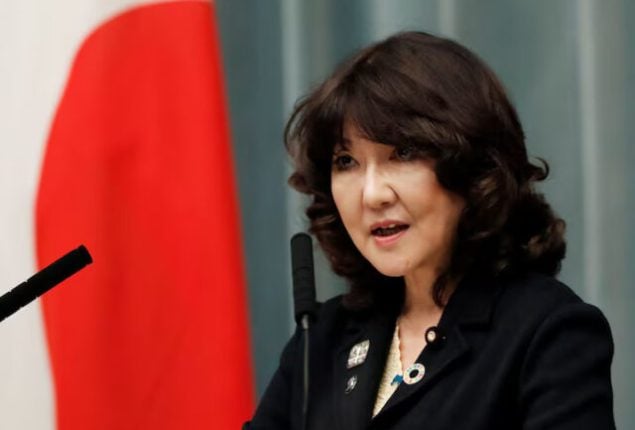
Japan’s minister in charge of local economic revitalisation Satsuki Katayama attends a news conference at Prime Minister Shinzo Abe’s official residence in Tokyo, Japan October 2, 2018. REUTERS/Issei Kato
TOKYO: Sanae Takaichi was appointed Japan’s first female Prime Minister on Tuesday, after clinching an unexpected majority in the first round of parliamentary voting.
Known for her conservative views and hardline stance on China, Takaichi will lead a minority government amid political turbulence and mounting domestic challenges.
Takaichi, 64, replaces Shigeru Ishiba as Japan’s fifth premier in five years. Her appointment comes just days before a scheduled visit from U.S. President Donald Trump, signaling high-stakes diplomacy ahead.
A former heavy metal drummer and long-time member of the ruling Liberal Democratic Party (LDP), Takaichi secured the LDP leadership on October 4. However, her socially conservative views and the shadow of an LDP slush fund scandal prompted the LDP’s coalition partner, Komeito, to withdraw support.
To form a government, Takaichi brokered a last-minute alliance with the right-leaning Japan Innovation Party (JIP), which pushes for bold reforms, including abolishing corporate donations and slashing the number of MPs. Their coalition agreement was signed Monday night.
A Trailblazer, But Not Without Controversy:
Often described as Japan’s answer to Margaret Thatcher, Takaichi has promised sweeping economic reforms and aims to boost female representation in her cabinet to “Nordic” levels. Currently, only 15% of Japan’s lower house MPs are women, and the country ranks 118th in the World Economic Forum’s 2025 Global Gender Gap Report.
While she has spoken openly about women’s health and menopause, Takaichi opposes allowing married couples to keep separate surnames and supports male-only imperial succession, placing her at odds with progressive voices.
Still, some in her hometown of Nara expressed hope. “She’s not like Trump. But she’s clear about what’s right and wrong,” said local pensioner Toru Takahashi.
Others, like 18-year-old student Nina Terao, hope for more: “I’d be happy if we saw more policies from a woman’s perspective – support for childcare, and help for women returning to work.”
Economic and Diplomatic Hurdles Ahead:
Takaichi inherits a daunting list of challenges. Talks with Washington over trade remain unresolved, while Trump is pressuring Tokyo to cease Russian energy imports and increase military spending.
On the domestic front, Japan’s economy continues to stagnate, and its population is in decline. Takaichi’s earlier support for aggressive fiscal stimulus under the “Abenomics” model has raised investor optimism, pushing stocks to record highs, though she distanced herself from those policies during the leadership contest.
A noted China hawk, Takaichi has previously warned that “Japan is completely looked down on by China.” However, she has recently softened her tone, notably skipping a controversial visit to the Yasukuni Shrine last week.
With her coalition holding a minority in both parliamentary houses, Takaichi will need bipartisan support to pass key legislation. Meanwhile, smaller populist parties like Sanseito are gaining traction amid voter dissatisfaction over inflation and stagnating wages.
As 77-year-old Nara resident Satoe Tominaga put it: “Prices have gone up, and it’s tough. Honestly, I mostly shop at 100-yen stores now.”
Takaichi’s success may hinge on whether she can deliver real reform while managing a divided legislature — and whether the country is ready to accept a woman not just as a symbolic first, but as a lasting leader.
Read More News On
Catch all the International News, Trending News, Breaking News Event and Latest News Updates on The BOL News
Download The BOL News App to get the Daily News Update & Follow us on Google News.




